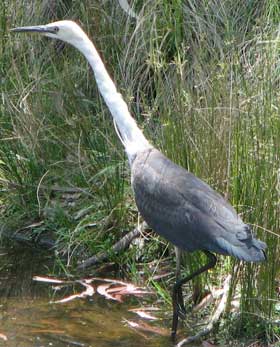A streak of white down on the little dam alerted me to something different happening there. It was some sort of bird.
I crept closer, staying below the fenceline, as the bird had frozen, clearly on the alert, its round eye bright with tension.
A solitary waterbird, with the typical long legs and neck and pointed beak, its pose held and twinned in the reflections below.
 But what was it? More important than identifying it now however, was to get a photograph, in case it flew off before I could see more details.
But what was it? More important than identifying it now however, was to get a photograph, in case it flew off before I could see more details.
I edged away and back up to the house for the camera. As I returned towards the fence, the bird did take off but only across the dam, where it stood, totally uncamouflaged, amongst the tussocks for a while.
Meanwhile I took up a post at the gate and froze like a statue myself, to reassure it.
 My bird book tells me it was a White-necked Heron.
My bird book tells me it was a White-necked Heron.
I wanted to ask it so much: where had it flown from? Was it on a Grand Tour, and where would it meet up with other such herons? Did it always fly solo? Why did its neck look like a twisted white rope? And did it realise how beautiful were the subtle mauves and tealy hues on its ‘grey’ feathers?
It wasn’t a long visit, and I may never see a White-necked Heron here again, but how special it was that it came — and that I saw.
Hi Sharyn, bloody acronyms! It stands for “all the best!” Apparently the black line disappears when they’re on heat. Have some wine an cheese for me when you’re at Singleton. (pronounced : singlet on, as opposed to “off”). Cheers, Trev.
Thanks for that Trevor. It did have a narrow dark line down the whole front of the neck; the pic I got of that aspect was too blurry, as the bird moved. It rarely faced me.
But I’m confused; does this mean it was definitely non-breeding then?
And what is ATB?
I’m relying on Simpson and Day here Sharyn, and looking closely at your photo as well, it appears that is non-breeding because it lacks the purple “plumes” on either side of its back. The other distinghisher of “breeding” is the absence a line of brown and black spots down its foreneck, but the bird is too side on in the photo to see. I’ve never been as close to one as this. Seen ’em in Watagan a fair bit on the lagoons, but my camera aint got a zoom. ATB, Trev.
Hi Trev, yes my dam has tall timber only at the back. But please, tell me the difference between its ‘non-breeding or breeding’ plumage.
Hi Sharyn, awesome bird (the Heron I mean), I’d guess your dam has something of a glide path. The dam on my place is surrounded by fairly obstructive timber which would force a rather tight spiral descent on an approaching bird of that size. Never forget the old saw: “If there’s pelicans on your dam, that’s a sure sign there’s water in it” Cheers, Trev. BTW, did you notice if the bird’s plumage was non-breeding or breeding?
I was lucky to have the story to share, DWG.
How perfectly beautiful is this wonderful bird!!
Great story with it!!! Thanks, DWG